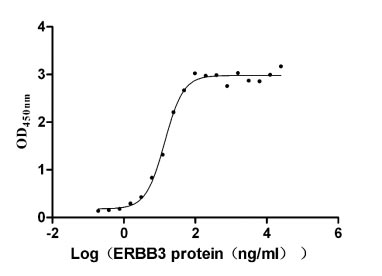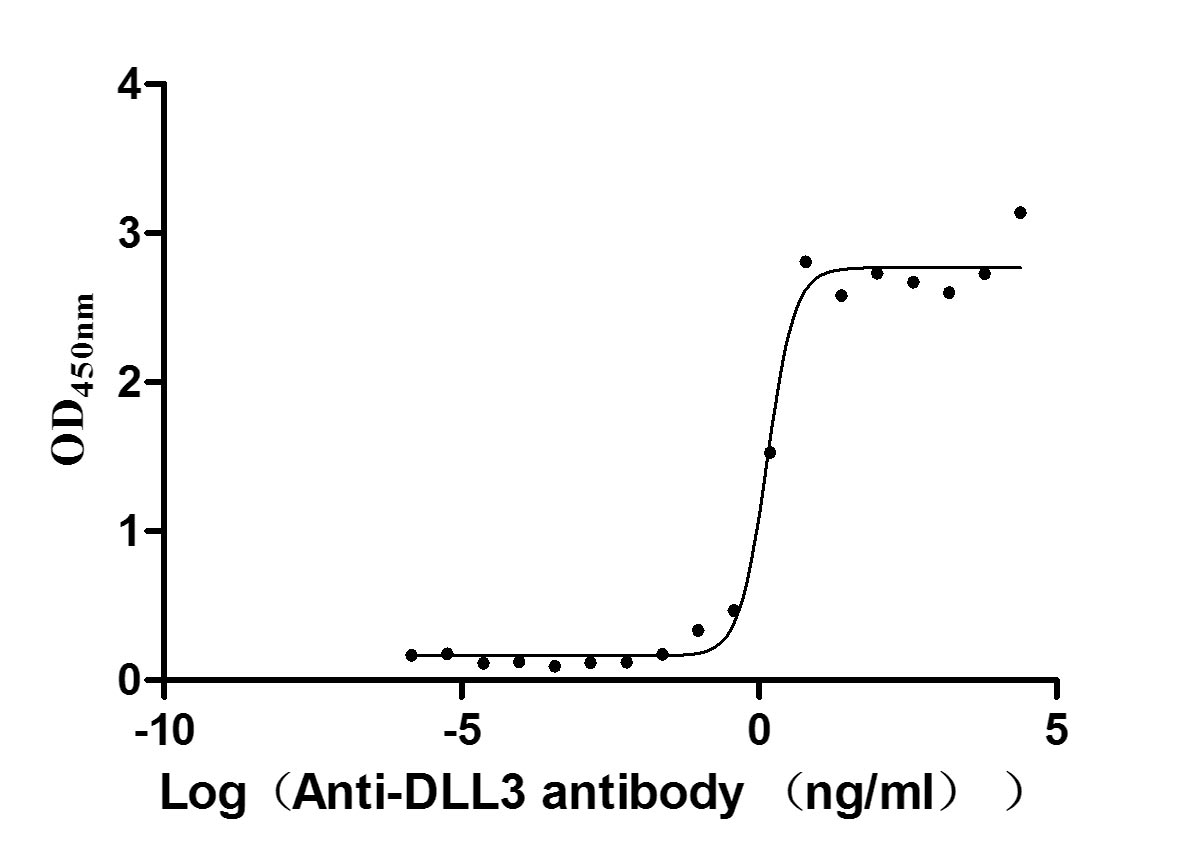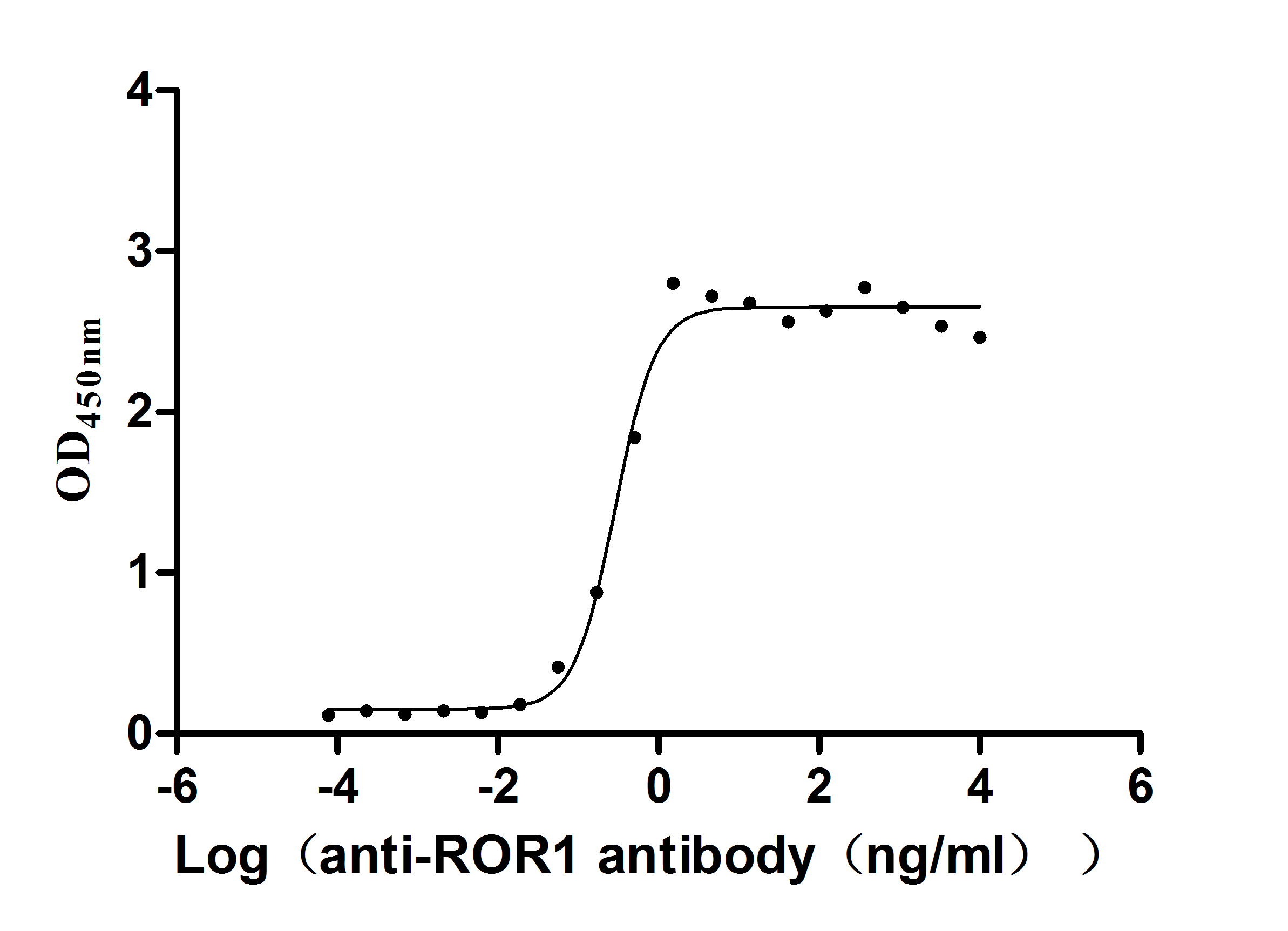Recombinant Human 26S proteasome non-ATPase regulatory subunit 9 (PSMD9)
-
货号:CSB-YP018914HU
-
规格:
-
来源:Yeast
-
其他:
-
货号:CSB-EP018914HU
-
规格:
-
来源:E.coli
-
其他:
-
货号:CSB-EP018914HU-B
-
规格:
-
来源:E.coli
-
共轭:Avi-tag Biotinylated
E. coli biotin ligase (BirA) is highly specific in covalently attaching biotin to the 15 amino acid AviTag peptide. This recombinant protein was biotinylated in vivo by AviTag-BirA technology, which method is BriA catalyzes amide linkage between the biotin and the specific lysine of the AviTag.
-
其他:
-
货号:CSB-BP018914HU
-
规格:
-
来源:Baculovirus
-
其他:
-
货号:CSB-MP018914HU
-
规格:
-
来源:Mammalian cell
-
其他:
产品详情
-
纯度:>85% (SDS-PAGE)
-
基因名:PSMD9
-
Uniprot No.:
-
别名:26S proteasome non ATPase regulatory subunit 9; 26S proteasome non-ATPase regulatory subunit 9; 26S proteasome regulatory subunit p27; Homolog of rat Bridge 1; MGC8644; p27; Proteasome (prosome macropain) 26S subunit non ATPase 9; Proteasome 26S non ATPase regulatory subunit 9; Proteasome 26S subunit non ATPase 9; PSMD 9; Psmd9; PSMD9_HUMAN; Rpn4
-
种属:Homo sapiens (Human)
-
蛋白长度:Full length protein
-
表达区域:1-223
-
氨基酸序列MSDEEARQSG GSSQAGVVTV SDVQELMRRK EEIEAQIKAN YDVLESQKGI GMNEPLVDCE GYPRSDVDLY QVRTARHNII CLQNDHKAVM KQVEEALHQL HARDKEKQAR DMAEAHKEAM SRKLGQSESQ GPPRAFAKVN SISPGSPASI AGLQVDDEIV EFGSVNTQNF QSLHNIGSVV QHSEGKPLNV TVIRRGEKHQ LRLVPTRWAG KGLLGCNIIP LQR
-
蛋白标签:Tag type will be determined during the manufacturing process.
The tag type will be determined during production process. If you have specified tag type, please tell us and we will develop the specified tag preferentially. -
产品提供形式:Lyophilized powder
Note: We will preferentially ship the format that we have in stock, however, if you have any special requirement for the format, please remark your requirement when placing the order, we will prepare according to your demand. -
复溶:We recommend that this vial be briefly centrifuged prior to opening to bring the contents to the bottom. Please reconstitute protein in deionized sterile water to a concentration of 0.1-1.0 mg/mL.We recommend to add 5-50% of glycerol (final concentration) and aliquot for long-term storage at -20℃/-80℃. Our default final concentration of glycerol is 50%. Customers could use it as reference.
-
储存条件:Store at -20°C/-80°C upon receipt, aliquoting is necessary for mutiple use. Avoid repeated freeze-thaw cycles.
-
保质期:The shelf life is related to many factors, storage state, buffer ingredients, storage temperature and the stability of the protein itself.
Generally, the shelf life of liquid form is 6 months at -20°C/-80°C. The shelf life of lyophilized form is 12 months at -20°C/-80°C. -
货期:Delivery time may differ from different purchasing way or location, please kindly consult your local distributors for specific delivery time.Note: All of our proteins are default shipped with normal blue ice packs, if you request to ship with dry ice, please communicate with us in advance and extra fees will be charged.
-
注意事项:Repeated freezing and thawing is not recommended. Store working aliquots at 4°C for up to one week.
-
Datasheet :Please contact us to get it.
相关产品
靶点详情
-
功能:Acts as a chaperone during the assembly of the 26S proteasome, specifically of the base subcomplex of the PA700/19S regulatory complex (RC). During the base subcomplex assembly is part of an intermediate PSMD9:PSMC6:PSMC3 module, also known as modulator trimer complex; PSMD9 is released during the further base assembly process.
-
基因功能参考文献:
- These data suggest that Schistosoma japonicum Sjp40 might inhibit hepatic stellate cell activation by promoting cellular senescence via SKP2/P27 signaling pathway. PMID: 28325896
- human epidermal growth factor receptor 2 (HER-2) levels, were correlated well with TSP50/p-Samd2/3 and TSP50/p27 expression status. Thus, our studies revealed a novel regulatory mechanism underlying TSP50-induced cell proliferation and provided a new favorable intervention target for the treatment of breast cancer PMID: 28650473
- Furthermore, inhibition of COPS5 resulted in an elevation of Akt expression and sensitized SOC cells to Akt inhibitor MK2206. Suppression of COPS5 and Akt offers a potential strategy for the treatment of SOC. PMID: 28919423
- Loss of p27 associated with risk for endometrial carcinoma arising in the setting of obesity. PMID: 26917264
- p53 immunopositivity was more frequent in SCC (65%) than in VC (23%) (P
- The PSMD9 intronic SNPs rs74421874 (IVS3+nt460 G>A) and rs3825172 (IVS3+nt437 C>T) remain significantly associated with insomnia only when taking into account anxiety -and not depression- as covariate. PMID: 26166263
- recurrence rate of p27 and/or PTEN-negative patients was higher than that of the positive ones,that should be followed up closely after treatment PMID: 26191286
- The present study provided the first evidences that miR-1470 mediated lapatinib induced p27 upregulation by targeting c-jun. PMID: 25545366
- Staining intensities of cell cycle inhibitors p27 and p57 significantly increased in all parts of preeclamptic placentas compared to control PMID: 24852133
- PSMD9 expression predicts radiotherapy response in breast cancer. PMID: 24673853
- Expression of Hath1, Muc2, cyclin D1 and p27 in the xenograft tumors was also detected. PMID: 23464457
- Describe PSMD9 gene SNPs in linkage to generalized anxiety disorder in type 2 diabetic families. PMID: 24648162
- The PSMD9 single nucleotide polymorphism(SNP)s IVS3+nt460, IVS3+nt437, and 197G are in linkage with overweight condition and waist circumference in Italians. PMID: 23282078
- Our results suggest that tuberin and p27 are aberrantly expressed in malignant breast tissue PMID: 23689538
- Surprisingly, we found that GRP/GRP-R differentially induced expressions of p21 and p27. Silencing GRP/GRP-R decreased p21, but it increased p27 expressions in neuroblastoma cells. PMID: 23618860
- PSMD9 IVS3+nt460 A>G and +nt437 C>T and exon 5 E197G A>G single nucleotide polymorphisms studied and/or any variants in linkage disequilibrium with them are linked to depression in our type 2 diabetes Italian families. PMID: 22934761
- the PSMD9 IVS3 + nt460, IVS3 + nt437, E197G SNPs are linked via the recessive model to microvascular pathology of type 2 diabetes (T2D) in Italians PMID: 22015693
- PSMD9 gene SNPs are linked to elevated blood pressure/hypertension in Italian families with type 2 diabetes. PMID: 21871126
- This study is the first to demonstrate the expression of Bridge-1 in human breast carcinomas. Bridge-1 expression is increased by activin A stimulation and itself seems to influence activin A signaling by affecting the expression of Smad2, 3 and 4. PMID: 21448710
- overexpression of Jab1, cytoplasmic p27, and pSer10p27 proteins is correlated with poor outcome in patients with glioma PMID: 21837501
- Brief Report: PSMD9 SNPs show linkage to carpal tunnel syndrome in Italian type 2 diabetics. PMID: 21862167
- genetic association studies in a population in Italy: SNPs in PSMD9 are strongly linked to diabetic neuropathy in subjects with type 2 diabetes; these associations show significance for an additive model-based inheritance. PMID: 21813292
- In summary, the PSMD9 IVS3+nt460, IVS3+nt437, E197G SNPs are linked to diabetic retinopathy and non-diabetic retinopathy in Italians. PMID: 21728808
- Data show that the PSMD9 IVS3 + nt460, IVS3 + nt437, E197G T2D risk SNPs are in linkage with diabetic nephropathy. PMID: 21439668
- PSMD9 SNPs IVS3 + nt460 A >G, IVS3 + nt437 C > T and E197G A > G are linked to the hypercholesterolemia phenotype in Italian type 2 diabetes families. PMID: 21554682
- PSMD9 IVS3+nt460A/G, +nt437C/T and exon E197G A/G SNPs are linked to coronary artery disease, stroke/TIA and macrovascular pathology of type 2 diabetes in Italians. PMID: 21496327
- Analysis of Gem-resistant sub lines also showed that loss of UBE2M and increased p27(Kip1) expression were associated with the acquisition of drug resistance. PMID: 21477582
- Cul1 regulates melanoma cell growth and cell cycle progression through degradation of p27 PMID: 20878082
- The expression of p53 and p27 was not related to HPV genotype in cervical carcinomas PMID: 19657726
- Show that the MODY3 mutation and the PSMD9 IVS3 + nt460A/IVS3 + nt437T/G197 SNPs are risk factors for type 2 diabetes in Italian families. PMID: 20069546
- Presence is associated with high nuclear grade, large tumor size, and poor prognosis for glioma patients. PMID: 12778072
- The researchers found evidence of increased positive identification of p27 following neoadjuvant therapy in colorectal cancer patients, p27 was a good predictor of FR in the pre-radiation biopsy, and p27(+) markers in specimens lived longer at 3 years. PMID: 17360176
- PSMD9 gene variants contribute rarely to late-onset type 2 diabetes in Italians. PMID: 17516568
- 8679o 78y PMID: 18694622
- We report a direct correlation between cyclin D3 and p27 expression in gastrointestinal stromal tumors. PMID: 18701138
- Bortezomib arrests the proliferation of hepatocellular carcinoma cells HepG2 and JHH6 by differentially affecting p27 level. PMID: 19041685
- In RCC, p27 is phosphorylated at T157 of the NLS, with increasing tumor grade associated with cytoplasmic p27. PMID: 19118035
- PSMD9 gene in the NIDDM2 locus is linked to type 2 diabetes in Italians. PMID: 19877155
显示更多
收起更多
-
蛋白家族:Proteasome subunit p27 family
-
组织特异性:Expressed in all tissues tested, highly expressed in liver and kidney.
-
数据库链接:
HGNC: 9567
OMIM: 603146
KEGG: hsa:5715
STRING: 9606.ENSP00000440485
UniGene: Hs.131151
Most popular with customers
-
Recombinant Human Receptor tyrosine-protein kinase erbB-3 (ERBB3), partial (Active)
Express system: Mammalian cell
Species: Homo sapiens (Human)
-
Recombinant Human Delta-like protein 3 (DLL3), partial (Active)
Express system: Mammalian cell
Species: Homo sapiens (Human)
-
Express system: Mammalian cell
Species: Homo sapiens (Human)
-
Recombinant Human Nectin-4 (NECTIN4), partial (Active)
Express system: Mammalian cell
Species: Homo sapiens (Human)
-
Recombinant Mouse Prolactin receptor (Prlr), partial (Active)
Express system: Mammalian cell
Species: Mus musculus (Mouse)
-
Recombinant Macaca fascicularis CD44 antigen (CD44), partial (Active)
Express system: Mammalian cell
Species: Macaca fascicularis (Crab-eating macaque) (Cynomolgus monkey)
-
Recombinant Human Myosin regulatory light polypeptide 9 (MYL9) (Active)
Express system: Yeast
Species: Homo sapiens (Human)
-
Recombinant Human Oncostatin-M (OSM), partial (Active)
Express system: Mammalian cell
Species: Homo sapiens (Human)




















